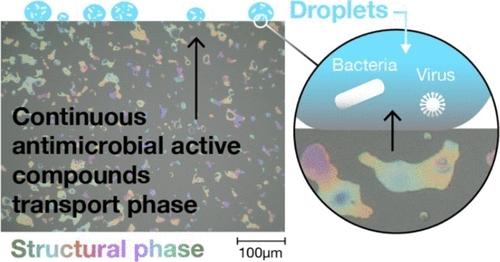活性化合物快速扩散的抗菌双相聚合物涂层
IF 3.9
2区 化学
Q2 CHEMISTRY, MULTIDISCIPLINARY
引用次数: 0
摘要
最近的COVID-19大流行和未来全球大流行的前景突出了长期以来被动消除表面病毒和细菌的必要性。传统的抗菌表面和涂层通常受到抗菌效果和物理耐久性之间权衡的限制。一种双相聚氨酯涂层通过将耐久性增强的聚碳酸酯(PC)离散相与连续的聚乙二醇(PEG)传输相结合,打破了这种权衡,聚乙二醇(PEG)传输相可以吸收、储存和释放抗菌活性化合物,延长微生物灭活时间。研究表明,这种双相聚合物可以吸收羧酸和季铵类抗菌活性化合物,在5年的模拟清洁后仍能保持其水平,并能灭活高达99.99%的人类冠状病毒229E和甲型H1N1流感病毒。此外,双相涂层上的抗菌活性化合物的水平可以通过用消毒剂清洁基材来提高。汽车和商业航空环境双相涂层的实用性通过双相成分显示硬度和耐污性控制,通过热、湿、光暴露显示环境耐久性,并通过可燃性协议得到证明。本文章由计算机程序翻译,如有差异,请以英文原文为准。

Antimicrobial Biphasic Polymer Coatings Enabled by Fast Diffusion of Active Compounds
The recent COVID-19 pandemic and the prospect of future global pandemics highlight the long-standing need to passively eliminate viruses and bacteria on surfaces. Conventional antimicrobial surfaces and coatings are typically constrained by a trade-off between antimicrobial efficacy and physical durability. A biphasic polyurethane coating has been developed that breaks this trade-off by incorporating a durability-imparting polycarbonate (PC) discrete phase with a continuous poly(ethylene glycol) (PEG) transport phase that absorbs, stores, and releases antimicrobial active compounds for extended microbial inactivation. The biphasic polymer was shown to absorb carboxylic acid and quaternary ammonium antimicrobial active compounds, maintained their levels after five years of simulated cleaning, and inactivated up to 99.99% of Human Coronavirus 229E and Influenza A H1N1. Furthermore, the levels of antimicrobial active compounds on the biphasic coating could be augmented by cleaning the substrate with a disinfectant. The practicality of biphasic coatings for automotive and commercial aerospace environments was demonstrated by showing control of hardness and stain resistance through biphasic composition, showing environmental durability through heat, humidity, and light exposure, and passing flammability protocols.
求助全文
通过发布文献求助,成功后即可免费获取论文全文。
去求助
来源期刊

Langmuir
化学-材料科学:综合
CiteScore
6.50
自引率
10.30%
发文量
1464
审稿时长
2.1 months
期刊介绍:
Langmuir is an interdisciplinary journal publishing articles in the following subject categories:
Colloids: surfactants and self-assembly, dispersions, emulsions, foams
Interfaces: adsorption, reactions, films, forces
Biological Interfaces: biocolloids, biomolecular and biomimetic materials
Materials: nano- and mesostructured materials, polymers, gels, liquid crystals
Electrochemistry: interfacial charge transfer, charge transport, electrocatalysis, electrokinetic phenomena, bioelectrochemistry
Devices and Applications: sensors, fluidics, patterning, catalysis, photonic crystals
However, when high-impact, original work is submitted that does not fit within the above categories, decisions to accept or decline such papers will be based on one criteria: What Would Irving Do?
Langmuir ranks #2 in citations out of 136 journals in the category of Physical Chemistry with 113,157 total citations. The journal received an Impact Factor of 4.384*.
This journal is also indexed in the categories of Materials Science (ranked #1) and Multidisciplinary Chemistry (ranked #5).
 求助内容:
求助内容: 应助结果提醒方式:
应助结果提醒方式:


